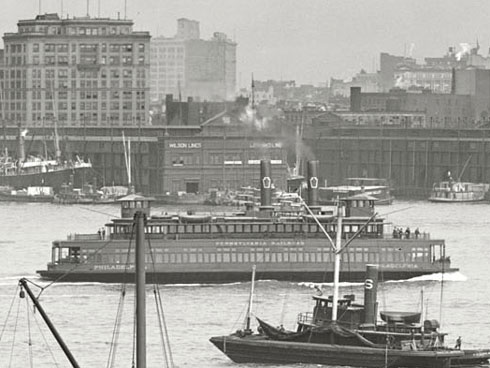


Framed or unframed, desk size to sofa size, printed by us in Arizona and Alabama since 2007. Explore now.
Shorpy is funded by you. Patreon contributors get an ad-free experience.
Learn more.

- Icing Platform?
- Indiana Harbor Belt abides
- Freezing haze
- Corrections (for those who care)
- C&NW at Nelson
- Fallen Flags
- A dangerous job made worse
- Water Stop
- Passenger trains have right of way over freights?
- Coal
- Never ceases to amaze me.
- Still chuggin' (in model form)
- Great shot
- Westerly Breeze
- For the men, a trapeze
- Tickled
- Sense of loneliness ...
- 2 cents
- Charm City
- What an Outrage
- Brighton Park
- Catenary Supports
- Just a Little Before I was Born
- Afternoon normal
- The Flat Iron Cafe survives
- Aging in Place
- Raise your hand
- Good and Bad
- Oh, the 70's
- Nooooooi
Print Emporium
Mysterious Missive: 1905

Hoboken, New Jersey. "Holland America Line piers." This two-plate composite showing the S.S. Potsdam at harbor could be looked at as a letter to the future -- five years into the future, if we compare it to the other Hoboken panoramas posted this weekend. Who can decipher the riddle? View full size.
The "Curious Tipsy Shed" has been moved and turned
Great photo's photos of the 1905 and 1910 HAL piers. I noted that the Curious Tipsy Shed has been moved and 90 degrees turned. The slanting side is in 1905 parallel to the pier, but in 1910 facing the pier. In the 1910 picture clearly various beams underneath the shed can be seen, working like a foundation. I wonder how they moved and rotated it, as the building must have had a considerable weight.
The Mystery of the Slanted Wall
In previous posts regarding the "tipsy building", I now see why the wall was slanted - the building was so close to the edge of the wharf that a rocking ship would hit it if it were NOT slanted!
Ferry nice view
The 1905 ferries would not look too out of place next to the 1965-built Staten Island Ferry MV John F. Kennedy.


Hey you
No pole leaning during daylight hours!
Yet another classic Shorpy image to peruse over for ten minutes or so.
Grain elevator "Renovator"
Further to my previous comment, out of curiosity I Googled 'Renovator floating grain elevator new york'.
I was astounded when Google turned up the following;
http://www.bklyn-genealogy-info.com/Newspaper/BSU/1882.Death.html
13 January 1882
A Watchman Drowned
Frank LECRAY, a watchman on the grain elevator Renovator, lying at the foot of Harrison Street, fell overboard from the deck of the elevator yesterday. Patrick KINSELLA and Manuel GARCIA hauled LECRAY out of the water, but he died before the arrival of the ambulance. The dead man was 50 years of age and lived at the corner of Henry and Poplar Streets.
Checking out the streets on Google showed that Frank Lecray lived just off the Brooklyn end of the Brooklyn Bridge, about 2 miles from where he was drowned off the Renovator. She was lying at the foot of Harrison Street which might well have been her regular berth and which is just across the Hudson (about 2 miles) from the Holland -America terminal. There's a 23 year disparity in the dates but a working vessel such as the Renovator would pay her way and was probably well maintained, so she might have lasted that long. There is also the possibility that a later elevator was given the same name. Much speculation but it seems reasonable enough.
Mmmmm boy, that was good.
Wow, it's the cannon mystery all over again. Now, let's find the rest of the building.
The letter "M"
Interesting because I left a comment last night which included a photo of the building on the left. I later found a photo which showed the area to the left. I second-guessed myself when I realized that it was a larger warehouse.
Now, I see it WAS part of a larger building. (In my defense, the photo was really small and I couldn't find one with better resolution so it was hard to tell).
And the letter is ... M
>> this could be looked at as a letter to the future -- five years into the future
I got it! The "tipsy house" in the 1910 photos is the front right corner of the previous 1905 Holland-America building. The letter M is still there.
[Excellent! Clapclapclap. - Dave]
Top Heavy
Looks like a floating grain elevator. It would enable ships carrying grain to be discharged without them having to be alongside a dedicated grain berth.
The long pipe hanging down the side of the structure would be hoisted into the ship's hold and the grain sucked out like a huge vacuum cleaner. There would be a similar arrangement on the other side of the structure whereby the grain would be discharged into barges.
[The other post says these are for loading ships, not unloading. But maybe it could go either way. - Dave]


























On Shorpy:
Today’s Top 5